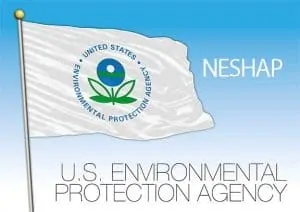


This action finalizes the residual risk and technology review (RTR) conducted for the Municipal Solid Waste (MSW) Landfills source category regulated under National Emission Standards for Hazardous Air Pollutants (NESHAP) contained within 40 Code of Federal Regulations (CFR) Part 63, Subpart AAAA. Additionally, the U.S. Environmental Protection Agency (EPA) is taking final action to:
The EPA is also finalizing minor changes to the MSW Landfills NSPS and Emission Guidelines (EG) and Compliance Times for MSW Landfills contained within 40 CFR Part 60, Subparts XXX and Cf. Specifically, the EPA is finalizing provisions to the most recent MSW Landfills NSPS and EG that would allow affected sources to demonstrate compliance with landfill gas control, operating, monitoring, recordkeeping, and reporting requirements by following the corresponding requirements in the MSW Landfills NESHAP. According to EPA, these final amendments will result in improved compliance and implementation of the rule and eliminate some of the confusion created by the previous version of the EPA rule.
We’ve pulled this information from the Final Amendments to Air Toxics Standards for Municipal Solid Waste Landfills and SCS will publish an SCS Technical Bulletin on our blog and social media sites. Please contact your Project Manager for details specific to your operation.
Approximately 738 MSW landfills are subject to the NESHAP.
On February 25, 2020, EPA finalized amendments to the 2003 NESHAP for MSW Landfills. EPA issued air toxics standards for the MSW Landfills source category in 2003 that established emission limitations based on maximum achievable control technology (MACT) standards for hazardous air pollutants (HAP) from major and area sources.
The rule required MSW landfills greater than 2.5 million megagrams (Mg) and 2.5 million cubic meters with uncontrolled emissions greater than 50 Mg/year of non-methane organic compounds (NMOC) to install and operate a gas collection and control system (GCCS). Most emissions from MSW landfills come from the continuous biodegredation of the MSW. Landfill gas contains methane, carbon dioxide and more than 100 different NMOC, including, but not limited to, vinyl chloride, ethyl benzene, benzene and toluene.
Based on the RTR, EPA is finalizing no changes to the existing standards because the agency determined the risks to be acceptable with an ample margin of safety to protect public health and the environment. In addition, EPA did not identify any new cost-effective emission controls for MSW landfills. However, EPA is finalizing several minor amendments to reorganize and streamline requirements for MSW landfills that will improve the clarity, compliance and implementation of the rule. These include:
The Clean Air Act (CAA) requires EPA to regulate toxic air pollutants, also known as air toxics, from categories of industrial facilities in two phases. The first phase is “technology-based,” where EPA develops standards for controlling the emissions of air toxics from sources in an industry group or “source category.” EPA bases these MACT standards on emission levels that are already being achieved by the best-controlled and lower-emitting sources in an industry. Within 8 years of setting the MACT standards, the CAA directs EPA to assess the remaining health risks from each source category to determine whether the MACT standards protect public health with an ample margin of safety and protect against adverse environmental effects. This second phase is a “risk-based” approach called residual risk. Here, EPA must determine whether more health-protective standards are necessary.
Every 8 years after setting MACT standards, the CAA requires EPA to review and revise the standards, if necessary, to account for improvements in air pollution controls and/or prevention and to address any residual risks that still remain after the MACT is implemented.
The CAA requires EPA to assess the risk remaining after application of the final air toxics emission standards; known as a residual risk assessment. Based on the completed risk assessment, available health information, and associated uncertainties, EPA determined risks from the MSW Landfills source category are acceptable and provide an ample margin of safety to protect public health. EPA estimates the maximum individual lifetime cancer risk for inhalation for the source category to be less than 10-in-1 million.
The CAA requires EPA to assess, review and revise air toxics standards, as necessary, taking into account developments in practices, processes and control technologies. The technology review of the standards for MSW Landfills did not identify any developments that would further reduce HAP emissions beyond the original NESHAP.
Download a copy of the final rule notice from EPA’s website at the following address: https://www.epa.gov/stationary-sources-air-pollution/municipal-solid-waste-landfills-national-emission-standards.
SCS will publish an SCS Technical Bulletin on our blog and social media sites. Please contact your Project Manager for details specific to your operation.
SCS Customer Support:
800-767-4727
Local Offices or Find a Specialist